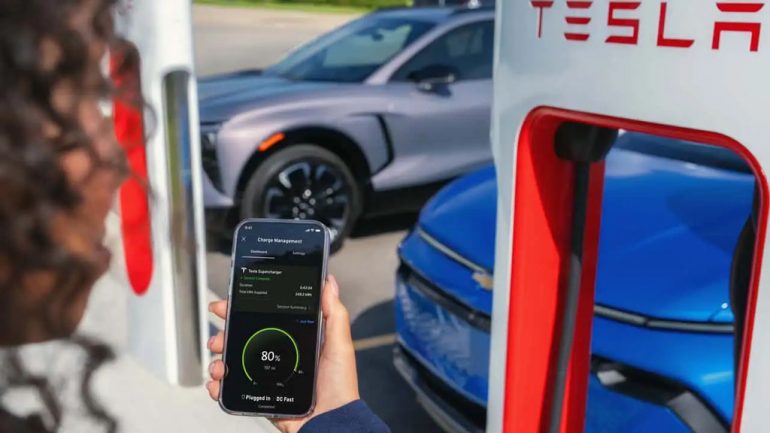
General Motors (GM) has finally opened up Tesla’s vast Supercharger network to its electric vehicle (EV) owners, offering access to over 17,800 charging stations across the U.S. and Canada. This expansion is a significant win for Chevy, GMC, and Cadillac drivers, giving them entry into one of the most reliable fast-charging networks, previously available to Tesla, Ford, and Rivian owners.
However, despite the doors being unlocked, GM EV owners won’t be able to charge up at Tesla Superchargers just yet. A key piece of the puzzle is still missing—the necessary adapter.
Also, don’t forget that you can get discounted new car pricing with a free quote through qualified local dealer partners.
To connect their EVs to Tesla’s Superchargers, GM owners will need a Combined Charging System (CCS) to North American Charging Standard (NACS) adapter. Priced at $225, the adapter isn’t being handed out for free, unlike Ford’s free rollout to its customers. GM has started taking orders for the adapters, which will ship directly to customers through the end of the year at no cost. However, the catch is clear: GM is still in the process of fulfilling demand and balancing its supply chain to ensure these adapters are readily available.

Vice President of GM Energy, Wade Sheffer, acknowledged the importance of keeping customers in the loop about adapter availability through the company’s apps (MyCadillac, MyChevrolet, or MyGMC), as well as through Tesla’s app. Yet, there’s still no solid timeline for when GM owners can expect their adapters to arrive in hand. In contrast, Ford has faced notable delays with its adapter rollout, and GM is hoping to avoid a similar scenario by sourcing from multiple suppliers.
While Ford and Rivian have integrated Tesla’s plug-and-charge system, which makes charging effortless, GM EV owners will need to initiate charging through their vehicle’s app or Tesla’s app. So, while Supercharger access is a big win, GM drivers won’t have the same seamless experience Tesla, Ford, and Rivian drivers currently enjoy.

But there’s another minor inconvenience. Tesla’s Superchargers are designed with shorter cables that perfectly align with Tesla’s rear driver-side charging port. GM EVs, with varying port placements, might force some drivers to park creatively to make the cables reach. While Tesla has reassured users that this is okay, it’s still an extra hurdle that GM owners will need to manage.
Though Supercharger access is a notable development for GM, the automaker emphasizes that it’s only part of its larger charging strategy. GM is investing in other fast-charging networks, including its partnership with EVGo, which offers 350-kW charging stations across the country. In fact, GM Energy and EVGo are working on opening 400 new fast-charging stalls, complete with much-needed features like canopies to shield drivers from the elements during long charging sessions.
GM is also involved in the Ionity-backed venture to install 30,000 new fast chargers by 2030, an ambitious project supported by automakers like Honda, BMW, and Mercedes. These new chargers, expected to offer amenities like retail options and canopies, are part of a broader vision to create more customer-friendly charging stations.

For urban EV owners, GM is pushing to install chargers in city centers, helping alleviate the challenges for those without home charging capabilities. Speaking of home charging, GM Energy is expanding its offerings, providing home chargers, backup batteries, and even Vehicle-to-Load (V2L) systems that allow vehicles to power household electronics.
While GM’s access to Tesla’s Supercharger network is a big win, it’s clear that the company is thinking long-term. With plans to build out more convenient and feature-rich fast-charging networks like the EVGo flagship stations and Ionity-backed stations, GM is betting on the future of charging infrastructure.
For now, Tesla Superchargers remain the gold standard in fast charging, offering GM drivers the best available option while the industry continues to evolve. As the next generation of chargers rolls out with improved features, amenities, and smarter locations, GM drivers will benefit from a more complete charging experience in the near future. But until then, the Tesla Superchargers offer an immediate boost to GM’s EV ecosystem, ensuring its drivers aren’t left behind.
This access may come with some minor inconveniences and costs, but it’s a crucial step forward in GM’s broader push to make EV ownership easier and more accessible for everyone. As GM continues to push boundaries in both charging tech and EV adoption, the future looks bright for its expanding electric fleet.